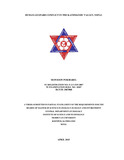Please use this identifier to cite or link to this item:
https://elibrary.tucl.edu.np/handle/123456789/1452| Title: | Human-Leopard Conflict in the Kathmandu Valley, Nepal |
| Authors: | Pokharel, Monsoon |
| Keywords: | Leopards;Conflict management;Vegetation |
| Issue Date: | 2015 |
| Publisher: | Central Department of Zoology Institute of Science and Technology Tribhuvan University Kirtipur, Kathmandu |
| Abstract: | The common leopard (Panthera pardus) is widely distributed large cat included in near threatened category of IUCN red list. In Nepal, common leopards are distributed widely in different protected areas and human dominated landscape. Human-leopard conflict is a major issue in the Kathmandu valley with death of leopards, injuries to human beings, and livestock losses. The main objective of this study was to assess the trend and causes of human-leopard conflict in the Kathmandu valley. Specific objectives were to find out frequency of leopard encounters and rescues, to explore the causes of conflict, to examine the change in forest cover change (2003-2013) with its appropriate mitigation measures in the Kathmandu valley. I collected data on leopard deaths/rescues, conducted questionnaire survey (n = 110) and analyzed satellite imagery of 2003 and 2013 using ArcGIS. Thirty eight human leopards encounter cases were recorded in 2010-2013 of which 50% leopards were found dead and the remaining 50% were rescued and released back to natural habitat. Seven leopards were found dead in the border area of Shivapuri National Park (SNP). Out of three districts in the valley, Kathmandu had the most human- leopard conflicts, and most of the dead and rescued leopards. Forest cover change into settlements, limited prey species in forest and insufficient awareness level of local communities were the major causes of human leopard conflict in the Kathmandu valley. During the period of 2003-2013 an area of 4011 hectare was converted from forest to barren land in the Kathmandu valley. Most of the human-leopard conflict cases occurred in forest cover change area. During encounters with leopards, human provocations have often resulted in aggressive nature of leopards. Afforestation, local education campaigns, and enhancement of wild prey populations hold much promise for reducing and better managing conflicts. |
| URI: | http://elibrary.tucl.edu.np/handle/123456789/1452 |
| Appears in Collections: | Zoology |
Items in DSpace are protected by copyright, with all rights reserved, unless otherwise indicated.

